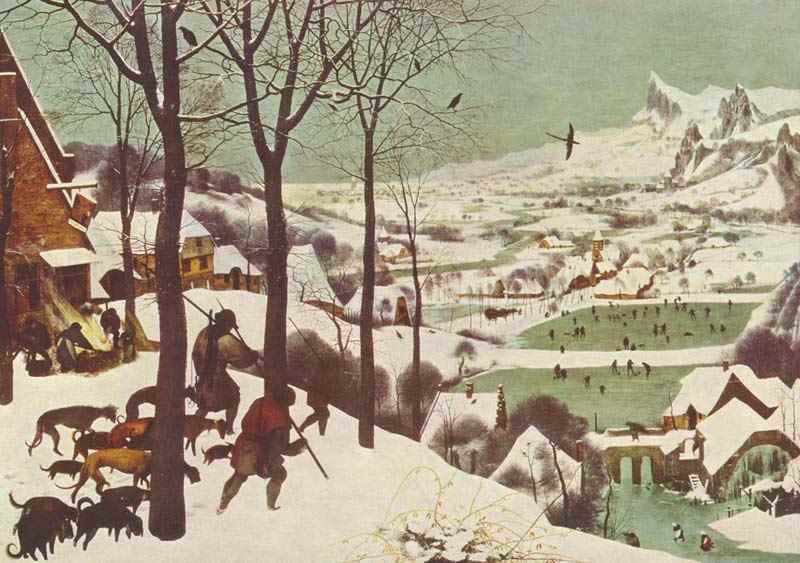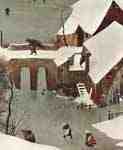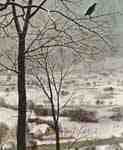
Cycle of the month pictures scene: Hunters in the Snow (January). Pieter Bruegel the Elder
1565, oil on wood
Vienna, Kunsthistorisches Museum
---
Zyklus der Monatsbilder, Szene: Heimkehr der Jäger (Monat Januar). Pieter Bruegel d. Ä.
1565, Öl auf Holz
Wien, Kunsthistorisches Museum
----
. Πήτερ Μπρίγκελ ο πρεσβύτερος
---
The Hunters in the Snow (Dutch: Jagers in de Sneeuw), also known as The Return of the Hunters, is a 1565 oil-on-wood painting by Flemish artist Pieter Bruegel the Elder. The Northern Renaissance work is one of a series of six, five of which still survive, that depict different times of the year. The painting is in the collection of the Kunsthistorisches Museum in Vienna, Austria.
 Hunters in the Snow ( January ) , detail
Hunters in the Snow ( January ) , detail
 Hunters in the Snow ( January ) , detail
Hunters in the Snow ( January ) , detail
Description
The painting shows a wintry scene in which three hunters are returning from an expedition accompanied by their dogs. By appearances the outing was not successful; the hunters appear to trudge wearily, and the dogs appear downtrodden and miserable. One man carries the "meagre corpse of a fox" illustrating the paucity of the hunt. The overall visual impression is one of a calm, cold, overcast day; the colors are muted whites and grays, the trees are bare of leaves, and woodsmoke hangs in the air. Several adults and a child prepare food at an inn with an outside fire.
The landscape itself is a flat-bottomed valley (a river meanders through it) with jagged peaks visible on the far side. A watermill is seen with its wheel frozen stiff. In the distance, figures ice skate, play hockey with modern style sticks and curl on a frozen lake; they are rendered as silhouettes.
Climate change
This is the most famous of several winter landscape paintings by Pieter Brueghel the Elder, which are all thought to have been painted in 1565, after an unusually severe winter, that has often been cited as the onset of a severe phase in the climatic period known as the Little Ice Age.
William James Burroughs analyzes the depiction of winter in paintings, and asserts, "quite wrongly", that this occurred almost entirely from 1565 to 1665 and was associated with the climatic decline from 1550 onwards. Burrough claims that before this, there were almost no depictions of winter in art, and "hypothesizes that the unusually harsh winter of 1565 inspired great artists to depict highly original images and that the decline in such paintings was a combination of the "theme" having been fully explored and mild winters interrupting the flow of painting".[1] In fact wintery scenes, which have technical difficulties in painting, had been regularly and very well handled since the early 15th century by artists in illuminated manuscript cycles showing the Labours of the Months, typically placed on the calendar pages of books of hours. January and February are typically shown as snowy, as in February in the famous cycle in the Les Très Riches Heures du duc de Berry, painted 1412-1416. Snowy scenes also appear in the early 14th century frescoes by Master Wenceslas for the Bishop's Palace at Trento,[2] and in a detail of Ambrogio Lorenzetti's Effects of Good Government in the City and Countryside (1337–39).[3] At this period independent landscape subjects had not developed as a genre in art, so the scarcity of other winter scenes is not remarkable.
Winter landscape with iceskaters, c. 1608, Hendrick Avercamp
His son Pieter Brueghel the Younger (1564-1638) also painted many snowy landscapes, though according to Burroughs as he "slavishly copied his father's designs. The derivative nature of so much of this work makes it difficult to draw any definite conclusions about the influence of the winters between 1570 and 1600...".[4]
Burroughs says that snowy subjects return to Dutch Golden Age painting with works by Hendrick Avercamp from 1609 onwards. There is then a hiatus between 1627 and 1640, before the main period of such subjects from the 1640s to the 1660s, which relates well with climate records for this later period. However the subjects are less popular after about 1660, but this does not match any recorded reduction in severity of winters, and may just reflect changes in taste or fashion. In the later period between the 1780s and 1810s, snowy subjects again become popular.[5]
Interpretation and reception
 Hunters in the Snow ( January ) , detail
Hunters in the Snow ( January ) , detail
 Hunters in the Snow ( January ) , detail
Hunters in the Snow ( January ) , detail
Pieter Bruegel the Elder, Hunters in the Snow (Winter), 1565, Smarthistory
The 1560s was a time of religious revolution in the Netherlands, and Bruegel (and possibly his patron) may be attempting to portray an ideal of what country life used to be or what they wish it to be.
Writing in the "opinion" section of Nature, art historian Martin Kemp points out that Old Masters are popular subjects for Christmas cards and states that "probably no 'secular' subject is more popular than ... Hunters in the Snow".[6]
Hunters in the Snow is used extensively in Russian director Andrei Tarkovsky's films Solaris (1972) and The Mirror (1974), and in Lars von Trier's 2011 film Melancholia.
References
Earth Environments: Past, Present and Future, by David Huddart & Tim Stott, p. 863 (quoted), 2010, John Wiley & Sons, ISBN 0470749601, 9780470749609
Florian Heine, "The First Time: Innovations in Art", Bucher, Munich, 2007 at 33
Philip McCouat, "The Emergence of the Winter Landscape", Journal of Art in Society, http://artinsociety.com
Earth Environments: Past, Present and Future, by David Huddart & Tim Stott, p. 863 (quoted), 2010, John Wiley & Sons, ISBN 0470749601, 9780470749609; see also this 1980 article by Burroughs in the New Scientist
Earth Environments: Past, Present and Future, by David Huddart & Tim Stott, p. 863 (quoted), 2010, John Wiley & Sons, ISBN 0470749601, 9780470749609
Kemp, Martin (December 2008). "Looking at the face of the Earth". Nature 456 (18): 876. doi:10.1038/456876a.
Kunsthistorisches Museum website
Hunters in the snow painting on Google Art Project
Further reading
Orenstein, Nadine M., ed. (2001). Pieter Bruegel the Elder: Drawings and Prints. The Metropolitan Museum of Art. ISBN 9780870999901. (see index)
----
Fine Art Prints | Greeting Cards | Phone Cases | Lifestyle | Face Masks | Men's , Women' Apparel | Home Decor | jigsaw puzzles | Notebooks | Tapestries | ...
----
Retrieved from "http://en.wikipedia.org/"
All text is available under the terms of the GNU Free Documentation License


